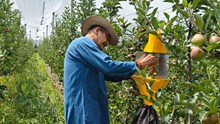
The Macherla sheep is an emerging meat-focused breed native to Southern India, especially prominent in the Guntur, Krishna, and Prakasam districts of Andhra Pradesh and neighboring areas of Telangana. Known for its unique coat patterns and robust growth, this breed contributes significantly to the livelihoods of rural farmers. Adapted to harsh environmental conditions and managed under extensive systems, the Macherla sheep stands out as an economically valuable and genetically unique livestock resource.
Macherla Sheep: Geographical Distribution and Habitat
Primarily raised in villages situated along the Krishna River basin, the Macherla sheep has a strong presence in Andhra Pradesh’s Guntur, Krishna, and Prakasam districts, as well as the Nalgonda district of Telangana. Locally referred to as Gukkala Jala or Guntur Local, the breed derives its name from Macherla town, situated at 16.48ºN latitude and 79.43ºE longitude with an average elevation of 136 meters.
The region receives an average annual rainfall of 830 mm, predominantly from the southwest and retreating monsoons. These moderate climatic conditions, characterized by dry spells and limited pasture availability, are well-suited to the Macherla sheep’s grazing abilities and resilience.
Physical Characteristics and Appearance
Macherla sheep are medium to large in size and instantly recognizable by their distinctive coat. Their bodies are predominantly white with large, irregular patches of black or brown across the face, legs, and torso. This patchy coloration varies widely among individuals, giving each animal a unique appearance.
Facially, Macherla sheep have a convex nasal bridge and black muzzle, contributing to their recognizable profile. Their ears are medium to large, leafy, and semi-drooping. Males typically have long, curved horns—averaging about 38.47 cm and ranging between 16 to 63 cm—while females are usually polled but occasionally develop small horns. The tail is small and slender, with docking commonly practiced by farmers who believe it enhances growth rates.
Size and Weight Profiles
The breed displays considerable size, especially in mature animals. Adult rams weigh between 38 and 69 kg, with an average weight of 55.76 kg. Ewes are comparatively lighter, ranging from 25 to 60 kg and averaging 43.59 kg. This notable body mass makes Macherla sheep a reliable choice for meat production.
Officially cataloged under accession number INDIA_SHEEP_0100_MACHERLA_14045, the breed is part of India’s recognized sheep genetic resources.
Growth Performance and Meat Production
Macherla sheep are primarily reared for mutton, and their growth performance supports this specialization. Lambs exhibit impressive weight gains even under extensive systems. At 1–3 months of age, lambs typically weigh between 4 and 26 kg; by 3–6 months, weights increase to 18–37 kg; and by 9–12 months, they range from 24 to 50 kg. This growth trajectory reflects the breed’s adaptability and value for meat production under minimal input conditions.
Management Practices in the Field
Farmers raising Macherla sheep generally follow an extensive grazing system. Flocks graze over long distances—typically 8–10 km daily—due to the limited forage availability around settlements. Grazing usually starts between 9:00 and 9:30 AM and continues until 6:00 or 6:30 PM, ensuring ample time for nutrient intake.
The average flock size is around 141 animals. A strong preference for breed purity exists, with 71.19% of flocks consisting entirely of Macherla sheep. Housing practices vary, with 48.39% of farmers keeping their animals in open areas and others providing nighttime shelter based on infrastructure and climatic conditions.
Though natural grazing remains the primary feeding strategy, around 25.81% of farmers supplement diets with concentrate feed during critical periods such as breeding, pregnancy, and weaning. Neem leaves are also occasionally given to lambs, believed to aid digestion and boost overall health.
Economic Importance and Market Demand
The Macherla sheep is in high demand for both breeding and meat. Male lambs are often sold at 3 months of age, fetching prices between Rs 2000 and Rs 4000 depending on their weight and condition. Breeding ewes command higher prices, typically ranging from Rs 8000 to Rs 10,000 due to their reproductive value.
Additionally, farmers earn supplementary income through penning services—charging Rs 3 per sheep per night to graze in harvested fields, which also serves as organic manure. Sheep droppings, collected and sold at Rs 800 to Rs 1000 per tractor trolley, contribute another revenue stream, underlining the breed’s role in integrated farming systems.
Health Management and Mortality Rates
Macherla sheep farmers proactively manage flock health through vaccinations against foot-and-mouth disease (FMD), peste des petits ruminants (PPR), sheep pox, and enterotoxemia (ET). Pneumonia is the most common issue among lambs, while adult sheep occasionally experience viral infections. Despite these challenges, mortality rates remain low—10–15% in lambs and ≤5% in adults—indicating effective management and disease control strategies.
Breeding and Reproductive Traits
Breeding is conducted through natural mating, with an optimal ram-to-ewe ratio of 1:33.59 to ensure genetic diversity and effective reproduction. Rams are selected based on size, physical conformation, and coat patterns to preserve breed standards.
Ewes generally attain sexual maturity by 12 months and have their first lambs between 18 and 24 months. With an annual lambing rate of 80–85% and moderate levels of twinning (reported by 5–15% of farmers, and over 20% by 13.33%), Macherla sheep support stable flock growth and farmer income.
Macherla sheep, a unique meat breed in Southern India, are vital to rural livelihoods due to their adaptability, growth, and market demand. Their economic and genetic importance warrants official breed registration. With ongoing research and improved management, Macherla sheep hold strong potential for sustainable livestock farming in Andhra Pradesh and Telangana.
















